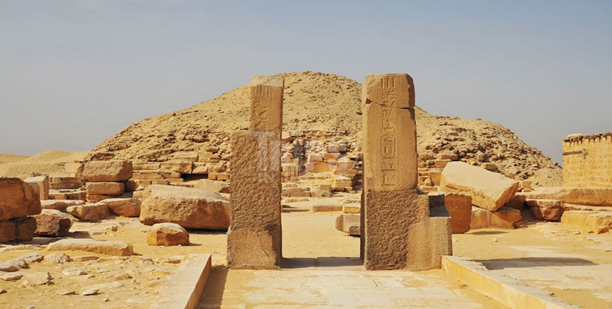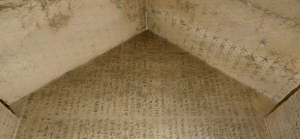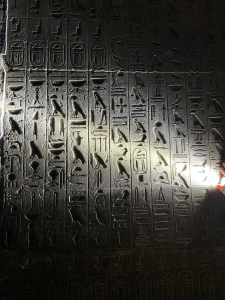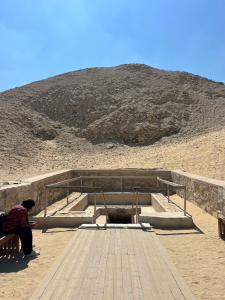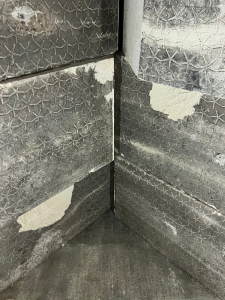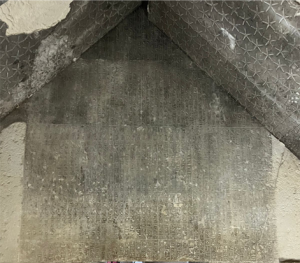The Pyramids of Saqqara
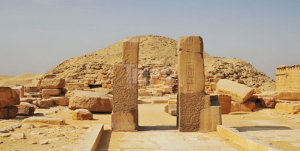
The Pyramids of Saqqara
After King Djoser built his step pyramid in Saqqara, some kings of the Third and Fourth Dynasties chose to build in areas near Saqqara. King Huni (Third Dynasty) built his pyramid in Meidum, south of Saqqara. King Snefru (Fourth Dynasty) built two pyramids in Dahshur. The kings of the Fourth Dynasty built their pyramids on the Giza Plateau, which is located north of Saqqara. The most important of these are the three pyramids of Khufu, Khafre, and Menkaure. In the Fifth Dynasty, King Userkaf and King Unas built their pyramids in Saqqara. Many kings of the Sixth Dynasty built their pyramids in Saqqara, the most important of which is the pyramid of King Teti.
Pyramid of Unas
King Unas, the last king of the Fifth Dynasty, built a pyramid that is a rare piece of beauty and grandeur. It remained buried under the sands until 1881 AD when it was discovered by the French scholar Maspero. The pyramid is 43 meters high and its base is 57.75 meters long. It was originally covered with a layer of limestone. The pyramid is located at the end of King Djoser’s pyramid complex. The entrance to the pyramid is through an entrance chamber that contains some statues. The entrance descends to a descending corridor that leads to a small room where there is a passage that opens onto a slightly larger room, and directly below it is the central axis of the pyramid. To the east of the front chamber, there is a small room that contained three niches where statues were placed. The tomb contains some of the most beautiful artifacts, but the most important thing is the presence of texts on the walls of the tomb that reveal to us the mentality and beliefs of the ancient Egyptians in what is known as the Pyramid Texts.
Burial Chamber
The burial chamber is located to the west of the front chamber. The basalt sarcophagus is still in place in the burial chamber. On the left of the sarcophagus, there was a canopic chest. The walls of the chamber are distinguished by beautiful and wonderful scenes called the Pyramid Texts.
Pyramid Texts
The texts of the Pyramid of Unas are a collection of ancient Egyptian religious texts. They are considered the oldest archaeological texts written since 2475 BC. These texts help us understand the development of religious thought in ancient Egypt. The texts presented creation stories, hymns to the gods, and the role of the gods in the order of the universe. The texts also present spells to protect the deceased and resurrection in the afterlife. Through the texts, the journey of the deceased is presented from his death and the beginning of his life in the afterlife. A group of texts is presented that helps the pharaoh overcome the obstacles of the afterlife, especially the snakes that he faces in his journey in the afterlife. The texts also provide him with a set of spells that make it easy for him to overcome all obstacles from demons and evil spirits that he encounters in his heavenly journey. These texts were depicted during the Old Kingdom era and developed in the Middle Kingdom and became known as the Coffin Texts. In the New Kingdom, they became known as a group of books such as the Book of the Dead and the Book of Amduat.
Pictures of Unas Pyramid
Pyramid of King Teti
King Teti was the founder of the Sixth Dynasty and the father of King Pepi I. He ruled from 2345 to 2323 BC. He built his pyramid near the complex of King Djoser. The pyramid was originally 52.5 meters high and was covered with blocks of limestone. The core of the pyramid consisted of small blocks of limestone and gravel, which caused the pyramid, when the outer casing was removed (since ancient times), to be unable to maintain its shape. The shape of the pyramid does not differ from the current mound, and fortunately, the internal structure is still intact. King Teti’s pyramid was a large pyramid, but unfortunately, it was not built with sufficient care and craftsmanship, which allowed thieves to steal the outer casing of the pyramid (since ancient times), which reduced the current height of the pyramid to no more than 20 meters. The entrance to the pyramid is at ground level. Above the entrance, a chapel for offerings was built, which contained a false door (the false door in ancient Egyptian times was used for the ka or Alka of the king or the spirit of the king to enter and exit. The entrance leads to a 15-meter-long corridor, then a hall, then a horizontal corridor with granite slabs, and then a hall. On the eastern side of it, there is a gap in the wall, and on the western side is the burial chamber.
Burial Chamber
The burial chamber still contains the basalt sarcophagus. It has a very beautiful ceiling decorated with stars (in the ancient Egyptian minds, this represents the universe and the celestial spheres). Scenes from the Book of the Pyramid Texts adorn the walls.
The Rest of King Teti’s Complex
Only parts of the funerary temple remain of King Teti’s complex. The entrance to the temple led to a hypostyle hall in the middle of the temple, and on either side of the entrance were offering storerooms. At the end of the hypostyle hall, there are steps leading up to the five niches. At the end of the temple, on the western side, we find the chapel, and there was a false door made of sandstone, the lower part of which is still in place. There are also some stones that used to decorate the pylon but are now lying on the ground. They are made of limestone and decorated with yellow stars on a blue background. The most important thing found in this temple is a stela of a deceased man’s face, believed to be of the king himself. The floor of this temple was made of marble.

